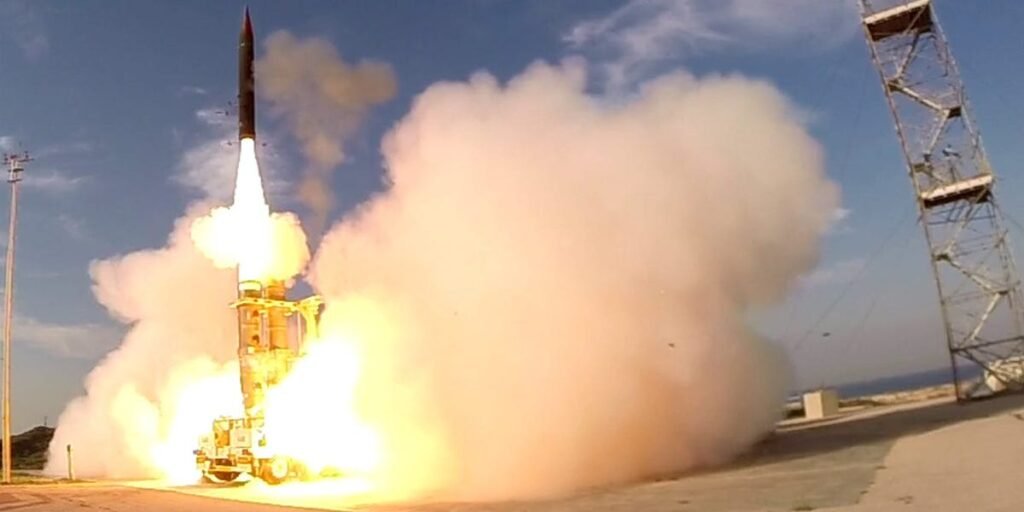Israel’s top ballistic missile defenses — its Arrow systems — were just tested in their third-ever direct conflict with Iran. The first two battles last year helped the manufacturer prepare for this latest fight, the toughest yet.
Boaz Levy, the CEO of the state-run Israel Aerospace Industries, told Business Insider in an interview on Wednesday that the company is “analyzing each missile attack” against Israel on a case-by-case basis, whether it’s a single shot or a barrage of fire.
“We do have lessons learned about system operation, about threat capabilities, and more,” he said.
The highly advanced Arrow systems are a joint product of IAI and the US aerospace contractor Boeing. Arrow 2, which was first deployed in 2000, can intercept missiles in the upper atmosphere. The newer Arrow 3 became operational in 2017 and can hit targets in space.
Both of the Arrow systems use a two-stage solid-fueled interceptor to destroy incoming ballistic missiles. Together, they make up the top echelon of Israel’s vaunted air defense network, the most famous part of which is Iron Dome for combating rockets, mortars, and artillery.
The Arrow systems have seen combat over the years, but they faced an unprecedented test in April 2024 when Iran fired some 120 ballistic missiles at Israel as part of a huge attack with cruise missiles and drones. Nearly all the threats were shot down.
Arrow then defended against another large-scale barrage in early October when Iran launched over 180 ballistic missiles at Israel. And over the following months, the system has frequently been used to intercept missiles launched by the Tehran-backed Houthi rebels in Yemen.
Levy, Arrow’s chief engineer, explained that all these engagements ultimately helped prepare Arrow for its most significant test yet: the most recent conflict with Iran, which fired hundreds of ballistic missiles at Israel over a 12-day stretch.
He said IAI develops Arrow in a “building blocks mechanism, which means that, every now and then, we are upgrading the system capability, utilizing a new building block.”
“During this time, between April last year to this attack, we did have several upgradations of the systems,” he said. “I believe that this is the right way to deal with it. So yes, we had lessons learned, and we improved the systems accordingly.”
“It’s a software change that will lead us to a better capability,” he added.
The latest conflict began on June 13, when Israeli officials announced the start of a new operation to degrade Iran’s nuclear program and its military capabilities. Israel then carried out sweeping airstrikes across the country over the next week and a half.
Iran retaliated by launching over 550 ballistic missiles and more than 1,000 drones at Israel, the latest Israeli government data shows. Most of those munitions were intercepted by air defenses.
Levy declined to say how many Iranian missiles Arrow engaged. But he said an initial analysis revealed that the systems intercepted at least 90% of the missiles that it targeted since June 13.
“I think that Arrow performed as expected,” Levy said. Israel said the Iranian missiles have caused over 50 impact sites across the country. Some missiles are allowed to go through if the impact site is irrelevant, but Iranian weapons have also, at times, made it through to strike civilian areas.
US Navy destroyers positioned in the Eastern Mediterranean Sea also provided air defense support for Israel in the latest conflict, as have American ground forces based in the Middle East. Available air defense assets in the region include MIM-104 Patriot surface-to-air missile batteries and the Terminal High Altitude Area Defense (THAAD) system.
US officials have not disclosed exactly how many Iranian missiles American forces shot down. Washington has provided air defense for Israel during all three of its clashes with Tehran.
Levy hailed the air defense partnership between Israel and the US, describing it as “the right way to deal with a ballistic missile attack. I believe that this collaboration and coalition between allies is the right solution for that, especially when we are speaking about salvos,” referring to large waves of attacks.
The US military joined Israel’s offensive campaign last weekend, using stealth aircraft and a guided-missile submarine to launch airstrikes on three of Iran’s top nuclear facilities. Tehran retaliated on Monday by firing a volley of missiles at a major American base in Qatar. That retaliation was neutralized by the Patriot systems.
Later that day, as Israel and Iran continued to trade attacks, President Donald Trump announced that the two countries had agreed to a ceasefire. Several days later, the fragile deal appears to be holding up.
Read the full article here


